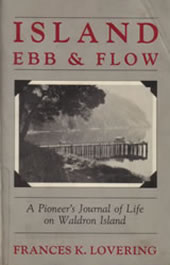Insights into Waldron Ways
Island Ebb & Flow: a Pioneer’s Journal of Life on Waldron Island ©1985 Frances K. Lovering
© 2008 Beth HelstienThis memoir of life on a remote island spans the middle of the twentieth century--from the 1930s through the 1970s.
Brimming over with place names and the names of Waldron and other San Juan County residents of those times, the book is no history, but a very intimate view of one woman’s courageous life.
Nonetheless, for contemporary readers with no relation to Lovering or other Waldronites, vignettes of specific aspects of daily life on Waldron deepen our understanding of our islands’ history. Building cabins and barns, starting a commercial egg business, bearing children, and caring for family are some of the themes depicted in Lovering’s early years.
Stories about the difficulty of communication with the “outside world” and the necessity for much self-reliance in medical matters remind us, especially those of us living on ferry-served islands, of the meaning of “remote”.
She organizes her book chronologically, but certain themes repeat from year to year. The difficulties of transport to the islands for people, mail, supplies and lumber is one recurring theme. Especially on Waldron, with no state funded ferry service, transportation posed (and still poses) a big challenge.
Neither the economy nor government influence can be completely escaped by refuge on Waldron. Regular U.S. mail service provided a foundation for shipping concerns that also moved people and goods. The delivery of mail by air became commercially viable in the 1960s, and that change, along with many societal changes of the post-war years, affected the Waldron community deeply.
Another important theme is education. Operating the Waldron School provided a variety of challenges: insufficient number of pupils, difficulties in securing a teacher who wanted to teach in a one- or two-room school, the cost of a new roof, or improvements to the outhouses. Lovering served on the school board, finding solutions.
Her sense of humor is shared most clearly when she is laughing at herself, and is evident throughout. Profiles of locals bring to life some of the characters of an island known for its eccentrics. Reading these, I craved longer accounts with even more detail. Personally, I prefer more narrative structure to accounts of people, places and times.
The storytelling based on the annual cycle is somewhat repetitious, but pioneers who lived close to the land knew that seasons were an important aspect of history. More than twenty cycles around the sun after its publication, Lovering’s book is still worth reading.
Island Ebb & Flow: a Pioneer’s Journal of Life on Waldron Island, like all books reviewed here, may be found at the San Juan Island Library.
